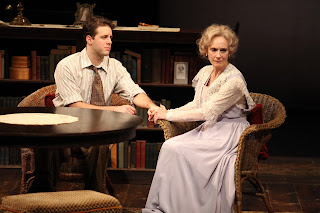 |
| Lisa Emery and David Chandler in Long Day’s Journey into Night. Photo by Alan Simons. |
Long Day’s Journey into Night
By Eugene O’Neill
Directed by Les Waters
Reviewed by Cristina Martin
Entire contents copyright ©2012 Cristina Martin. All rights reserved.
Art imitates life, it is said. In an openly autobiographical work, the premise is clear. But if in the work’s execution, the life or lives depicted are so exquisitely and intimately drawn – if the work resonates in three dimensions and consumes and moves – then we’re convinced we really are witnessing Life, in a sense, and not just its imitation. To accomplish this takes a master’s hand, and no playwright for the American stage merits the title of master more than Eugene O’Neill. In Actors Theatre’s current production, O’Neill’s Pulitzer Prize-winning Long Day’s Journey into Night comes alive in all its devastating glory, providing insight into O’Neill’s own life and beyond.
Written in 1940, Long Day’s Journey into Night depicts one day in August of 1912 at the seaside cottage of the Tyrone family. James Tyrone (David Chandler) and his wife, Mary Cavan Tyrone (Lisa Emery), have always spent the summers here, a seasonal respite from the itinerant life that James’s acting career demanded. It was an existence filled with “…one-night stands, cheap hotels, dirty trains…,” as Mary is wont to remind the family. Elder son Jamie (Michael Bakkensen) and his ailing brother Edmund (John Brummer) are also present. The more that is revealed about these characters and their backgrounds, the more profoundly intricate the web of relationships among them proves to be. Love and resentment, regret and longing, anger and pain, remembrance and forgetting, illness and frailty, and faith and oblivion – these are the subjects that O’Neill treats. It’s a push and pull of the utmost intensity, a jumble of contradictions as untidy as life itself. O’Neill shows us the human heart laid bare in the suffering and struggle that is its fate.
The Tyrones were clearly modeled after O’Neill’s own family (he being Edmund). In dedicating Long Day’s Journey into Night to his wife Carlotta, he wrote, “I give you the original script of this play of old sorrow, written in tears and blood. […] I mean it as a tribute to your love and tenderness which gave me faith in love that enabled me to face my dead at last and write this play – write it with deep pity and understanding and forgiveness for all the four haunted Tyrones.” The playwright left specific instructions that it was not to be published until 25 years after his death and never performed, though Carlotta overrode his wishes; it premiered in 1956, roughly two and a half years after O’Neill’s passing.
Under Les Waters’ direction, each actor in the production truly mines the depths of his or her role. By play’s end, there is no one whom we love or hate overwhelmingly, or even predominantly – a fact that speaks to the skill with which the ensemble portrays infinitely complex, multi-faceted characters. We’re overwhelmed with the wretchedness and tragic plight of the Tyrones, though the pathetic and the maudlin are deftly avoided. At times, I wanted to shake my fist at them; at times to cradle them in my arms.… To what extent is each a victim of happenstance, and to what extent are they responsible for their own suffering? It’s a question that may be debated ad infinitum.
I’ve read a number of versions of Long Day’s Journey into Night in which a fifth character appears briefly, a young domestic named Cathleen who keeps Mary company for a while, listens to her ramblings, and injects a note of groundedness into the troubled family. This production eliminates her, making Mary’s scene with Cathleen into a monologue. The effect is to make the play sparer and starker; it’s just the four Tyrones and their ghosts whom we behold, no one else. If Cathleen acts as a sort of anchor or tether to the outside world, then without her, the Tyrones are really unmoored. Collectively and individually, they’re lost in the fog of their own suffering, isolated alone and as a group.
Antje Ellermann’s extraordinary set is open and likewise spare. The carefully selected furniture and set pieces do a remarkable job of evoking an entire house without ever stealing focus from the actors. The scenic design follows O’Neill’s explicit stage directions which describe the layout of the cottage. In a subtle and brilliant touch, different rooms and spaces are distinguished from one another not by walls, but by varied patterns of planking in the floorboards. Ellermann’s set bears a striking resemblance to photographs of the real summer cottage where the O’Neill family spent time, but it manages admirably to reinforce the lean aesthetic of this production at the same time.
On the very wide, rounded stage, the characters seem exposed physically as much as they are emotionally. Lorraine Venberg’s costumes, perfectly suited to the characters and to the era, never contain tones that jar or overwhelm or keep us from seeing the people in them for what they really are. The fog mentioned so often in the play really does roll into the theatre; and the large, curved back wall filled with a life-sized photograph of the seashore, with a building in the foreground and the ocean stretching into infinity, contributes to the mood of haunted loneliness. Sound designer Richard Woodbury’s melancholy soundscape does, too, with its foghorn, ships’ bells, sea sounds and occasional austere piano chords.
While all four actors inhabit their characters masterfully, Lisa Emery is a standout, fully credible and utterly heartbreaking as Mary. After Edmund’s birth, Mary was given morphine for her pain and soon became addicted. She’s been able to kick the habit for varying periods of time; but when we see her in 1912, the pull of the drug has become irresistible once again. Emery is able to seem at once fragile and hard-headed, child-like but dissipated. Her gradual transformation from scene to scene as Mary falls increasingly under the influence is extraordinary. In the flutter of her hands, her increasingly loose-limbed movement and the shadows that pass over her chiseled features, Mary’s pain becomes palpable.
The men in the family numb themselves (or try to, at any rate) with the help of alcohol. Alcoholism was prevalent in O’Neill’s family, as it is among the Tyrones; tragically, the playwright’s elder brother, James O’Neill, Jr., died of the disease in 1923. It’s interesting that the drunker the two brothers were on stage, the meatier the dialogue between them; the meatier the dialogue, the better a vehicle for the talents of both Bakkensen and Brummer. Though they’re supposed to be close, I didn’t get a convincing impression of this closeness in their first several scenes. Bakkensen’s Jamie came off as slightly stiff, while Brummer seemed retiring and weak as Edmund.
In the second half of the production, however, they redeem themselves a thousand fold. I can still see Jamie’s frightening, malevolent sneer as he describes his cruel impulse to bring those around him down so as to feel better about himself. At the same time, however, Jamie shows himself to be truly, deeply aggrieved to learn that Edmund has been diagnosed with tuberculosis. Brummer, for his part, shines in poignant conversations with Mary as well as in the defense of his modern tastes in literature vis-à-vis his father. We’re even treated to some moments of wry humor in their discussion (“IB-sen!” James spits, with exaggerated contempt).
David Chandler’s interpretation of James Tyrone, Sr., diverged perhaps most widely of all the characters from how I had envisioned him from my reading of the play. Particularly at the beginning, Chandler seemed to seethe, any affection for his sons well masked by James’s cruel and sarcastic mien. He’s supposed to be cynical, but O’Neill notes that James also possesses (albeit on rare occasions) “…the remnant of a humorous, romantic, irresponsible Irish charm […] with a strain of the sentimentally poetic.” Happily, this came through after intermission, when Chandler’s James became considerably more sympathetic. He displayed a far greater range of emotion and emerged as the multi-dimensional character the playwright presumably intended.
Matt Frey’s lighting was well designed, though I felt that Day could have turned into Night a bit more gradually. When Mary mentions at a certain point that it is getting dark, it’s particularly incongruous to see her surrounded by rather bright light. But the twisting on and off of the chandelier bulbs as James struggles with his penny-pinching nature is wonderful. It allows for some interesting movement and some welcome lighter moments, in both senses of the term.
In general, however, Long Day’s Journey into Night is far more tenebrous and far more weighty that it is light. I left troubled and raw, and the Tyrones still haunt me days afterwards. Such was O’Neill’s family, but such is the human family, too: swimming in a sea of contradictory passions, ever battered, keeping our heads above water but sometimes giving in to the urge to self-destruct. There are far more questions to be pondered than answers, and answers that contain both the Thing and its Opposite. It is perhaps this quality in O’Neill’s wrenching tour de force that makes Long Day’s Journey into Night a thoroughly modern work.
Long Day’s Journey into Night
October 9-28, 2012
Actors Theatre of Louisville
Pamela Brown Auditorium
316 West Main Street
Louisville, KY 40202
(502) 584-1205




